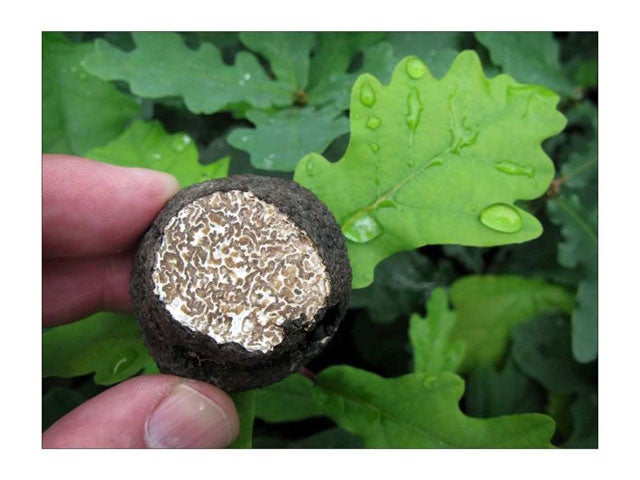Wet summers bring flood of truffles

The mystical allure of the truffle spans the centuries. Greeks and Romans associated the fungi with sex and power, attributing to it therapeutic and aphrodisiac powers. Brillat Sauvaurin, the 18th-century French gourmet, once remarked that truffles aroused erotic and gastronomic memories.
France and Italy have long dominated the notoriously secretive tuber trade. But Britain is now succumbing to truffle fever.
Two years of wet, humid summers have seen truffles thrive in Britain – and top chefs are desperate to get their hands on them. Among those trying to find them is Dr Paul Thomas, a biologist who admits to obsessing about the wealth of fungi that grow in our forests.
To most Britons, the truffle is probably little more than an overpriced clump of pungent oddness that Continentals get perplexingly excited about. But Dr Thomas is helping to change that. He believes truffles were historically just as much a part of Britain's culinary identity as they are across the Channel. Now he and a small but growing group of farmers and scientists are resurrecting Britain's truffle industry.
Taking a knife from his pocket Dr Thomas slices off a small section of a summer truffle, the most common species to grow naturally on British soil. The knobbly dirt-covered skin makes it look like a pebble but, once sliced in two, the characteristic marbled flesh is unmistakable. "They're wonderful," he says. "That marbling effect is the spores inside. Once a truffle is ripe it lets off a lovely smell."
That depends on your definition of lovely. The earthy smell of truffles is often unkindly compared to unwashed underpants, but to gastronomes it is a flavour worth paying for, with the summer truffle alone fetching up to £300 per kilogram. France's Périgord will set you back £850 while the Italian white truffle costs an eye-watering £4,000 per kilo.
With such sums changing hands, it is little wonder that British entrepreneurs are starting to notice. Nigel Hadden-Patton sells a small number of summer truffles from a secret site in the heart of Wiltshire, where the alkaline soil provides ideal conditions for truffles to flourish. "We sell as many as we can get out of the ground at the moment," he says.
At the start of the 20th century, Britain was host to a vibrant truffle industry, largely centred around the chalk downs of Hampshire and the Winterslow area of Wiltshire. Local hunters would use trained Spanish poodles to look for the "black diamonds" beneath beech, oak and hazel trees. But the industry died out and the last of that generation's professional truffle-hunters, Alfred Collins, retired in 1930.
The revival, though, is under way. "We have now got about nine large plantations across the south of England," says Mr Hadden-Patton. "It takes a long time for a plantation to start producing once it has been infected with the fungi. You usually have to wait for between eight and 10 years."
But Dr Thomas is helping to change that. His method of inoculating young tree roots with the fungal spores that go on to form truffles produces quicker results, with 80 per cent of the roots showing tuber growths compared to the 30 per cent resulting from Continental methods. He has also begun inoculating mature trees, which can produce truffles within two years of infection.
One such secret mature plantation is in the heart of Herefordshire. Truffle growers jealously guard the location of their sites, for fear of poachers stealing their crop.
"The man and his van is always a bit of a fear," says Tim Gilbert, who asked Dr Thomas's Mychorrhizal Systems to inoculate hundreds of hazel trees on his farm last year. "I guess once we start producing people will know who we are, but I'd like to keep a low profile until then."
Going underground
* A truffle is essentially a tangled mess of mycelium, the vegetative part of a fungus, and fungal spores.
* When the truffle is ripe, the mycelium and spores come together to form the hard, marbled nugget on the surface of the forest floor.
* When a tree is first infected by the truffle fungus, thread-like microscopic roots of mycelium attach themselves to the root and then spread into the soil around. At that point, everything to do with the truffle is below ground.
* The mycelium forms a symbiotic relationship with the tree. The truffle roots increase the surface area of the tree's roots, bringing extra nutrients from the soil into the tree. In return, the tree gives the truffle sugar and glucose to grow because truffles cannot photosynthesise.
* When the truffle is ready to germinate, the mycelium coils up into a hard nugget and produces spores. Animals then eat the truffles and spread the spores when defecating.
* Summer truffles ripen, as the name suggests, in the summer, and can be found across Britain from late July . The French Périgord and Italian white truffles are usually found in late autumn.
* The most expensive truffle was a 750g white truffle discovered in the hills above Alba, Italy, by Luciano Savini and his dog Rocco. It was sold to a casino owner for £165,000.
Join our commenting forum
Join thought-provoking conversations, follow other Independent readers and see their replies
0Comments